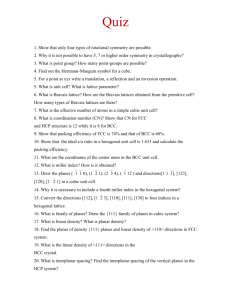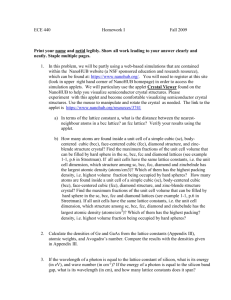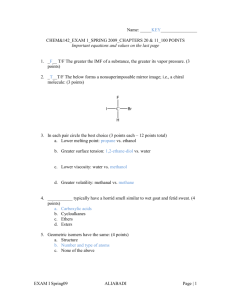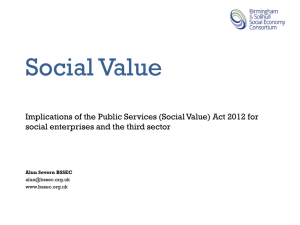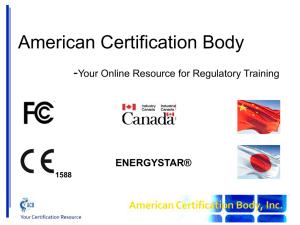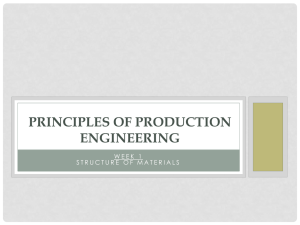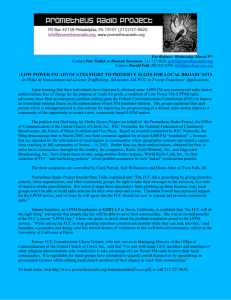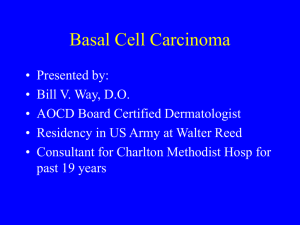Sample - Fog.ccsf.edu
advertisement
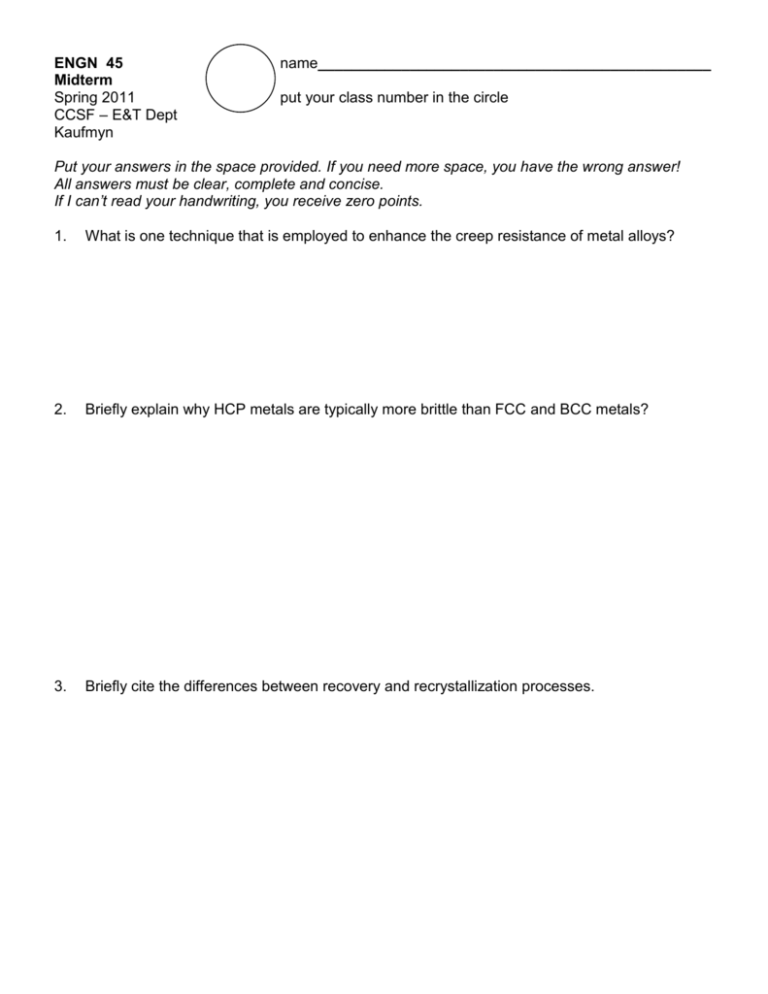
ENGN 45 Midterm Spring 2011 CCSF – E&T Dept Kaufmyn name_______________________________________________ put your class number in the circle Put your answers in the space provided. If you need more space, you have the wrong answer! All answers must be clear, complete and concise. If I can’t read your handwriting, you receive zero points. 1. What is one technique that is employed to enhance the creep resistance of metal alloys? 2. Briefly explain why HCP metals are typically more brittle than FCC and BCC metals? 3. Briefly cite the differences between recovery and recrystallization processes. 4. Two previously undeformed cylindrical specimens of an alloy are to be strain hardened by reducing their cross-sectional area (while maintaining their circular cross sections). For one specimen, the initial and deformed radii are 16mm and 11mm, respectively. The second specimen, with an initial radius of 12mm, must have the same deformed hardness as the first specimen; compute the second specimen’s radius after deformation. 5. Determine the carburizing time necessary to achieve a carbon concentration of 0.45 wt% at a position 2 mm into an iron-carbon alloy that initially contains 0.20 wt% C. The surface concentration is to be maintained at 1.30 wt% C, and the treatment is to be conducted at 1000oC. ( R = 8.31 J/mol K) Note: For this system Do = 2.3 x 10 –5 m2/s & Qd = 148kJ/mol 6. Why is the diffusivity, D, larger for carbon in ferrite (bcc iron) than for carbon in austenite (fcc iron)? 7. Why is carbon more soluble in austenite (fcc iron) than in ferrite (bcc iron)? 8. For an FCC crystal, such as aluminum, would you expect the surface energy for a (100) plane to be greater or less than that for a (111) plane? Why? 9. Calculate the radius of a vanadium atom, given that V has a BCC crystal structure, a density of 5.96 g/cm3, and an atomic weight of 50.9 g / mol. 10. Define the Yield Strength of a material. 11. Define Fracture Toughness of a material. 12. Define Creep. 13. Define Fatigue. 14. Define Endurance Limit. 15. Why are covalently bonded materials are generally less dense than ionically or metallically bonded ones?. ENGN 45 Midterm - KEY Spring 2011 CCSF – E&T Dept Kaufmyn 1. What is one technique that is employed to enhance the creep resistance of metal alloys? make the grains coarser (less grain boundaries) 2. Briefly explain why HCP metals are typically more brittle than FCC and BCC metals? hcp has less slip systems (potential directions for deformation to occur) than bcc or fcc. (It has 3 as opposed to 12 in fcc and bcc.) 3. Briefly cite the 2 main differences between recovery and recrystallization processes. 1) recovery has no significant change in the crystal structure (it is just the beginning of a full annealing process) - in recrystallization the crystal lattice has been entirely replaced with new grains 2) in recovery ductility is slightly increased – in recrystallization it is greatly increased 3) in recovery the strain energy of the crystal lattice is slightly decreased – in recrystallization the strain energy of the crystal lattice is greatly decreased (such that it is at minimum value) 4) in recovery the strength is slightly decreased, in recrystallization, it it greatly decreased 4. Two previously undeformed cylindrical specimens of an alloy are to be strain hardened by reducing their cross-sectional area (while maintaining their circular cross sections). For one specimen, the initial and deformed radii are 16mm and 11mm, respectively. The second specimen, with an initial radius of 12mm, must have the same deformed hardness as the first specimen; compute the second specimen’s radius after deformation. They need to have the same amount of CW in order to have the same deformed hardness! Amount of CW in first specimen: %CW = (Ao – Af)/Ao %CW = [ (16mm)2 - [ (11mm)2] / (16mm)2 %CW = 52.7% Amount of CW in second specimen: %CW = (Ao – Af)/Ao 52.7%= [ (12mm)2 - [ r2] / (12mm)2 Solving for r: r = 8.25mm 5. Determine the carburizing time necessary to achieve a carbon concentration of 0.45 wt% at a position 2 mm into an iron-carbon alloy that initially contains 0.20 wt% C. The surface concentration is to be maintained at 1.30 wt% C, and the treatment is to be conducted at 1000oC. Note: for this system Do = 2.3 x 10 –5 m2/s & Qd = 148kJ/mol Solution: Use Fick’s Second Law: where cx = 0.45 co = 0.20 cs = 1.3 0.7727 = Using table: = 0.854 where x = 0.002 D = Doe-Qd/RT =(2.3 x 10 –5 m2/s) e-(148000 J/mol) / (8.31J/mol-K)(1273K) = 1.93 x 10 –11 m2/s Solving for t: t = 7.1 x 10 4 s = 19.73 hours 6. Why is the diffusivity, D, larger for carbon in ferrite (bcc iron) than for carbon in austenite (fcc iron)? bcc structure has larger pathways (It is not a close packed structure) than fcc so the activation energies for diffusin are lower. Hence diffusion is easier and a larger value of the diffusivity 7. Why is carbon more soluble in austenite (fcc iron) than in ferrite (bcc iron)? fcc structure has larger interstitial sites (holes) than bcc so more atoms will fit inside with less distortion 8. For an FCC crystal, such as aluminum, would you expect the surface energy for a (100) plane to be greater or less than that for a (111) plane? Why? The surface energy of the (100) plane would be greater than the surface energy of the (111) plane because it is NOT a close packed plane like the (111) plane is. (The closer together the atoms, the lower the energy.) 9. Calculate the radius of a vanadium atom, given that V has a BCC crystal structure, a density of 5.96 g/cm3, and an atomic weight of 50.9 g / mole. density = mass / volume = mass of the unit cell / volume of the unit cell mass of the unit cell = mass of 2 atoms (bcc): (2 atoms) x (1 mole/ 6.02 x 1023 atoms) x (50.9 g / mole) = 1.69 x 10-22 g volume of the unit cell = a3 For bcc: a = 4R/3 volume of the unit cell = (4R/3) 3 5.96 g/cm 3 = (1.69 x 10-22 g) / (4R/3) 3 Solving for R: R = 1.3 x 10-8cm = 1.3 x 10-10 m = 0.13 nm 10. Define the Yield Strength of a material. The value of stress when the material first starts to yield (plastically deform). 11. Define Fracture Toughness of a material. The value of the stress intensity factor when the material fails (breaks). 12. Define Creep The phenonoma where a material will deform very slowly at elevated temperatures over long periods of time. 13. Define Fatigue. The penonoma where a material will fail (break) after many cycles of loading, even when the load puts the material in a stress much less than the yield strength. 14. Define Endurance Limit. The level of stress below which the material will not ever break, no matter how many cycles of of loading it is subjected to. If the material does not have a true endurance limit, then it is the level of stress where the material can sustain 108 cycles before failing. 15. Why are covalently bonded materials are generally less dense than ionically or metallically bonded ones?. Covlanent bonds are highly directional and do not maximize packing efficiency like ionic and metallic bonds do.
